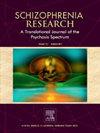Emotional maltreatment shapes the relationship between psychosocial functioning and hippocampal structure in schizophrenia spectrum disorders
IF 3.5
2区 医学
Q1 PSYCHIATRY
引用次数: 0
Abstract
Background
The hippocampus and amygdala are important limbic structures involved in memory, emotional regulation, and stress response, which are pivotal for social interactions, everyday functioning, and participation in community life. However, the presumably bidirectional relationship between limbic structure and psychosocial functioning—and the potential moderating role of early-life environmental risk factors—remains poorly understood in schizophrenia spectrum (SSD) and mood disorders (MOD).
Methods
Structural 3 T MRI data were collected from SSD (n = 64) and MOD (n = 66) patients as well as healthy controls (HC, n = 46). Hippocampal subfields and amygdala nuclei were segmented using FreeSurfer v7.3.2. Psychosocial functioning was assessed with the Personal and Social Performance Scale (PSP). Childhood maltreatment, urban upbringing, and migration background were examined as potential moderators.
Results
SSD patients showed significant volume reductions in left hippocampal subfields compared to HC (FDR-corrected p < .05). Within SSD, PSP scores were associated with volumes of the left hippocampal body, tail, and molecular layer (FDR-corrected p < .05), with emotional abuse and neglect significantly moderating these associations. No other environmental risk factors showed significant interaction effects. In MOD, only the left fimbria differed from HC (FDR-corrected p < .05), but this was unrelated to PSP scores, and no significant interactions were found.
Conclusion
Our findings indicate that early-life emotional adversity moderates the relationship between psychosocial functioning and hippocampal structure in SSD, but not in MOD, highlighting the need to consider emotional trauma histories when investigating functional outcomes in SSD patients.
精神分裂症谱系障碍的情感虐待塑造了社会心理功能和海马结构之间的关系。
背景:海马体和杏仁核是重要的大脑边缘结构,参与记忆、情绪调节和应激反应,对社会交往、日常功能和社区生活的参与至关重要。然而,在精神分裂症谱系(SSD)和情绪障碍(MOD)中,边缘结构和社会心理功能之间可能存在的双向关系以及早期生活环境风险因素的潜在调节作用仍然知之甚少。方法:收集SSD (n = 64)、MOD (n = 66)患者及健康对照(HC, n = 46)的结构3 T MRI数据。使用FreeSurfer v7.3.2对海马亚区和杏仁核进行分割。采用个人与社会表现量表(PSP)评估心理社会功能。儿童虐待、城市抚养和移民背景被认为是潜在的调节因素。结论:我们的研究结果表明,早期生活中的情感逆境调节了SSD患者的社会心理功能和海马结构之间的关系,但在MOD中没有,这突出了在调查SSD患者的功能结局时考虑情感创伤史的必要性。
本文章由计算机程序翻译,如有差异,请以英文原文为准。
求助全文
约1分钟内获得全文
求助全文
来源期刊

Schizophrenia Research
医学-精神病学
CiteScore
7.50
自引率
8.90%
发文量
429
审稿时长
10.2 weeks
期刊介绍:
As official journal of the Schizophrenia International Research Society (SIRS) Schizophrenia Research is THE journal of choice for international researchers and clinicians to share their work with the global schizophrenia research community. More than 6000 institutes have online or print (or both) access to this journal - the largest specialist journal in the field, with the largest readership!
Schizophrenia Research''s time to first decision is as fast as 6 weeks and its publishing speed is as fast as 4 weeks until online publication (corrected proof/Article in Press) after acceptance and 14 weeks from acceptance until publication in a printed issue.
The journal publishes novel papers that really contribute to understanding the biology and treatment of schizophrenic disorders; Schizophrenia Research brings together biological, clinical and psychological research in order to stimulate the synthesis of findings from all disciplines involved in improving patient outcomes in schizophrenia.
 求助内容:
求助内容: 应助结果提醒方式:
应助结果提醒方式:


